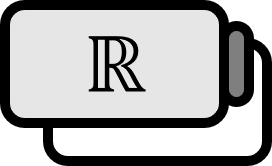The Definition of Euler's Number, the Base of the Natural Logarithm e
Definition1
The limit of the series below is defined as constant $e$.
$$ e: = \sum \limits_{n=0}^{\infty} \dfrac{1}{n!} $$
Explanation
Even if we do not know what that value is right away, it can be easily shown that the series mentioned above converges to some limit. The partial sum $s_{n}$, as it is bounded and increasing, converges.
$$ \begin{align*} s_{n} &= 1 + 1 + \dfrac{1}{2} + \dfrac{1}{2 \cdot 3} + \dfrac{1}{2 \cdot 3 \cdot 4} + \cdots + \dfrac{1}{1 \cdot 2 \cdot \cdots \cdot n} \\ &< 1 + 1 + \dfrac{1}{2} + \dfrac{1}{2 \cdot 2} + \dfrac{1}{2 \cdot 2 \cdot 2} + \cdots \dfrac{1}{\underbrace{2 \cdot 2 \cdot \cdots \cdot 2}_{n-1}} \\ &= 1 + 1 + \dfrac{1}{2} + \dfrac{1}{2^{2}} + \dfrac{1}{2^{3}} + \cdots \dfrac{1}{2^{n-1}} \\ &< 1 + 1 + 1 < 3 \end{align*} $$
Theorem
$$ \lim _{n \to \infty} \left( 1 + \dfrac{1}{n} \right)^{n} = e $$
Or
$$ \lim _{n \to 0} \left( 1 + n \right)^{\frac{1}{n}} = e $$
It’s fine to define it as such. In the Wade textbook2, it is defined this way.
Proof
Let’s assume
$$ s_{n} = \sum \limits _{k=0}^{n} \dfrac{1}{k!},\quad t_{n}=\left( 1 + \dfrac{1}{n} \right)^{n} $$
$$ (x+y)^{n} = \sum_{r=0}^{n} {_n C _r} x^{n} y^{n-r} $$
Then, by the binomial theorem, the following holds.
$$ \begin{align*} t_{n} &= {_{n}C_{0}} \cdot 1 + {_{n}C_{1}} \dfrac{1}{n}+ {_{n}C_{2}}\dfrac{1}{n^{2}} + {_{n}C_{3}}\dfrac{1}{n^{3}} + \cdots + {_{n}C_{n}}\dfrac{1}{n^{n}} \\ &= 1 + n \dfrac{1}{n}+ {_{n}C_{2}}\dfrac{1}{n^{2}} + {_{n}C_{3}}\dfrac{1}{n^{3}} + \cdots + {_{n}C_{n}}\dfrac{1}{n^{n}} \\ &= 1 + 1+ \dfrac{1}{2!}n(n-1)\dfrac{1}{n^{2}} + \dfrac{1}{3!}n(n-1)(n-2)\dfrac{1}{n^{3}} + \cdots + \dfrac{1}{n!}n(n-1)\cdots 2 \cdot 1\dfrac{1}{n^{n}} \\ &= 1 + 1+ \dfrac{1}{2!}\left(1-\dfrac{1}{n}\right) + \dfrac{1}{3!}\left(1-\dfrac{1}{n}\right)\left(1-\dfrac{2}{n}\right) + \cdots + \dfrac{1}{n!}\left(1-\dfrac{1}{n}\right)\left(1-\dfrac{2}{n}\right)\cdots\left(1-\dfrac{n-1}{n}\right) \end{align*} $$
Therefore, $\forall n\in \mathbb{N}, t_{n} \le s_{n}$ and the following equation holds.
Also, if $n \ge m$, then the following holds.
$$ t_{n} \ge 1 + 1+ \dfrac{1}{2!}\left(1-\dfrac{1}{n}\right) + \dfrac{1}{3!}\left(1-\dfrac{1}{n}\right)\left(1-\dfrac{2}{n}\right) + \cdots + \dfrac{1}{m!}\left(1-\dfrac{1}{n}\right)\left(1-\dfrac{2}{n}\right)\cdots\left(1-\dfrac{m-1}{n}\right) $$
Note that the RHS is not $t_{m}$ but omits a few terms from the back of $t_{n}$. Now, applying $\lim \inf \limits_{n\ to \infty}$ for a fixed $m$ yields the following equation.
$$ \liminf \limits_{n \to \infty} t_{n} \ge 1 + 1+ \dfrac{1}{2!} + \dfrac{1}{3!} + \cdots + \dfrac{1}{m!} $$
Then, taking the limit of $m \to \infty$ on both sides yields the following.
$$ \begin{equation} \liminf \limits_{n \to \infty} t_{n} \ge e \label{eq2} \end{equation} $$
Thus, by $\eqref{eq1}, \eqref{eq2}$, the following holds.
